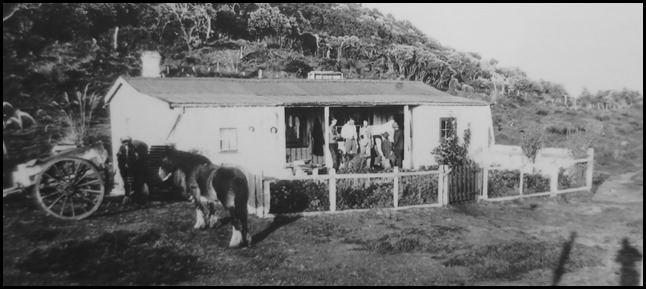Early Settlers

Beez Neez now Chy Whella
Big Bear and Pepe Millard
Wed 6 Aug 2014 22:37
|
The Early Settlers of Island
Hill Homestead, Stewart Island
 Halfmoon Bay with the early houses
of Oban.
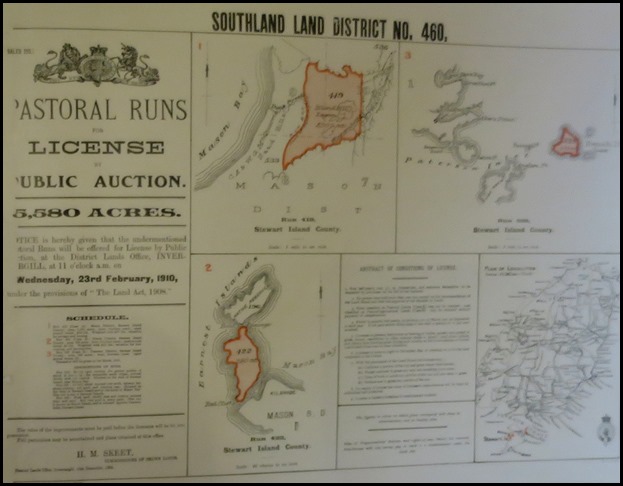 The Department of Conservation has
managed to put together the story of one homestead on the island. Fascinating
social history. Challenging it may have been, but they
loved it. Lifestyle, a love of nature and the hope of ‘making a few shillings’
in lean times seems to have been common factors in bringing men and their
families to Mason Bay. For one hundred and eight years they pushed the
geographic, physical and economic limits of farming.
In 1867 the Commissioner of Crown
Lands, W.H. Pearson mapped a ‘paper town’ named Kilbride at the southern end of
Mason Bay. It was one of several settlements planned around the Stewart Island
coast in a deluded dream that became known as ‘Pearson’s Paradise’. Despite the
plan’s failure, Pastoral Run No.419 was advertised for auction in 1879. This
area of five thousand acres covered the drier dune land behind Mason Bay. In
1902, Run 533 was created to include the original settlement site of Kilbride.
This run, now five thousand, five hundred and eighty acres came up for auction on the 23rd of
February 1910.
 William Walker built the original Island Hill homestead.
William Walker was the first
runholder worked hard to dig drainage ditches and fence his stock, which he
increased to sixteen hundred sheep. He and his wife were known for their
hospitality, always offering a welcome on the mat, even if it was only made of
sack. They were here from 1879 to 1893.
Welles Orton Charlton was born in
Leicester, England. This titled Englishman married Laura Thompson, a Southland
widow. While he and his two stepsons farmed at Mason Bay – 1893 - 1913, Laura
stayed with her maids at the Traveller’s Rest above Harrold Bay, near Halfmoon
Bay. In 1902, William Thompson took up the new Kilbride Run while his brother
Cyril remained at Island Hill. One of Mrs. Thompson’s maids recalled beautiful
Christmas cakes baked at Kilbride during a summer visit, using black-backed
gulls’ eggs.
When Charlton and Cyril Thompson left
Island Hill, the run had a series of short term tenants, including Dr. James
Black, professor of chemistry at Otago University and sheep farmer John
Borne.
By 1926 the original homestead had been extended. Arthur Traill Junior. The Traill
family spent every spring and summer, 1923 – 1942, at Mason Bay tending their
flock of twelve hundred sheep – an eagerly anticipated annual adventure. Arthur
Traill supplemented their income by trapping possums, a newly introduced pest on
the island. For the remainder of the year, Arthur Traill was a
fisherman.
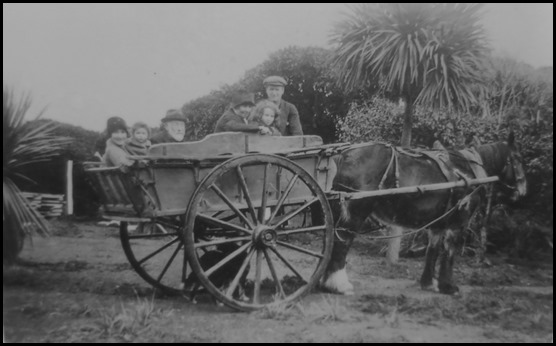 A Traill family
outing at Duck Creek, 1929.
 The Leask
family. Back: Laurence Keast – friend, Peter and Ian Leask. Front:
Stanford, Dolly and Cyril Leask.
Stanford and Dolly Leask and their
family lived and worked here for twenty three years from 1942 to 1965, improving
the land until they were able to run fifteen hundred sheep. It was an advantage
that Stanford’s brother George farmed the Kilbride run next door.
In the absence of shops and freezers,
self-sufficiency was important. Meat was hung in a small meat safe, still
standing today. Sheep manure from the woolshed and bull kelp from the beach
helped to grow good crops of carrots, parsnips and potatoes.
 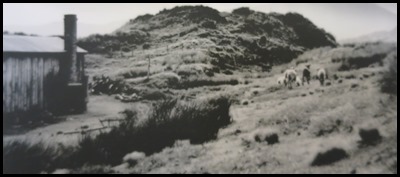 The Leask, originally from the Orkney
Islands of Scotland built the woolshed in 1953. Its
timbers were gathered from the beach, mostly ‘dunnage’ used to hold a ship’s
cargo in place and chucked overboard at the end of a voyage.
Extra help was needed for the annual
muster and the children often played the part of sheep dogs. Fencing was another
challenge and despite a considerable commitment from the Mason Bay farmers, for
the most part sheep wandered freely over the run. Driftwood and fishing nets
featured in improvised paddocks. maintaining fences on the shifting dunes was an
added headache as they alternatively became buried or left hanging in the air.
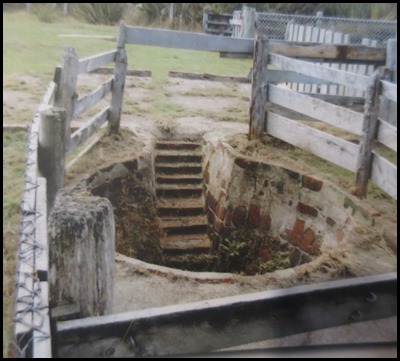 Some of the bricks used to construct
the narrow sheep dip came from a chimney at the
Island Hill homestead............
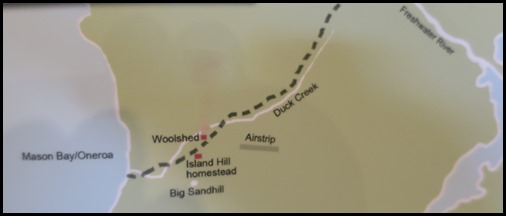 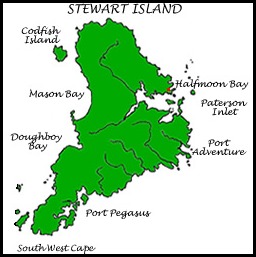 ..........the remainder were shipped
from Halfmoon Bay to Freshwater Landing - just off
the map up Freshwater River where they were picked up by horse and cart. Stewart Island showing Mason Bay
and Paterson Inlet.
 Once shearing was over, the hard part
began. Over the years, farmers tried a variety of ways to transport their wool
clip to Bluff or Invercargill – none of them straightforward. In the early
years, the main option was to cart the wool to Freshwater Landing and store it
in the sheds there. When the weather and tide were favourable, it was shipped
across Paterson Inlet to Halfmoon Bay.
Stanford Leask and his brother George
bought the Nightingale. This gave them another transport option.
Stanford carted the wool six miles from Island Hill to a large shed at Kilbride
where it stayed until the conditions were right. A horse and dray then took it
through the breakers to a waiting dinghy which rowed out to
the Nightingale. The journey continued across the nineteen miles
of Fovreaux Strait and Invercargill’s New River Estuary. The wool was finally
unloaded at a wharf where the Stead Street Bridge now crosses the Waihopai
River.
 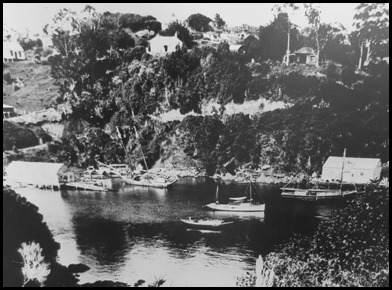 The Nightingale at Freshwater Landing. Leask’s Bay
1916, named after Tom Leask. This quiet bay has been the site of boat building,
a trying out depot and a fish cannery established in 1875.
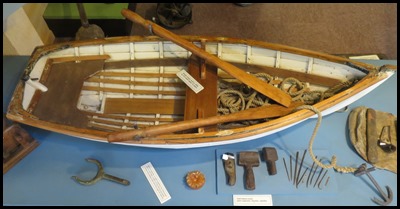 A model dinghy
made by Alf Leask.
 Island Hills’ last farmer, Tim Te Aika was in his element, mixing farm activities with
hunting, deer recovery and possum trapping. For his wife Ngaire, it was much
harder. She had to manage without electricity; home school their two daughters
and buy stores that would last for up to two months.
The ethic of ‘making do’ continued
until the end. A beachcombing discovery of wood staves from tallow barrels ended
up as the homestead’s picket fence.
Up to fifteen hundred sheep were
shorn here every summer. The shed was designed for two shearers working
side-by-side. By the time Tim took over hand shearing had been replaced by
electric clippers powered first by a tractor and later by an eight kilovolt
generator. It was the ‘bone of contention’ for Tim’s wife Ngaire that the
woolshed enjoyed electricity while their home had none...
Tim tried a third option for getting
the wool over to the mainland – by air. Landing a plane on the beach was
uncertain so he used his tractor to plough a six hundred metre airstrip through
the tussock grass. His son-in-law pilot flew in bags of superphosphate and
carried a bale of wool out. Even with family goodwill, it wasn’t economic. Today
the airstrip has fast been reclaimed by the tussock grass but the remains of
deep drains and buried fence posts are still visible.
Tim Te Aika gave up his lease to the
Government in 1986, after being here for twenty years, the last sheep were
removed the following year. The Department of Conservation now cares for the
homestead and its outbuildings as a historic resource that provides insight to a
fascinating chapter of island life.
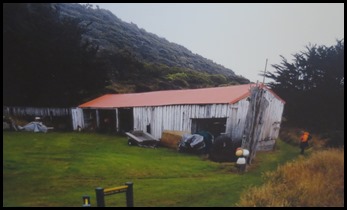  The
workshop and the woolshed as they stand today.
Cared for in the main by volunteers.
 The homestead
today.
ALL IN ALL PIONEERING AND
TOUGH
AN AMAZING
STORY |
